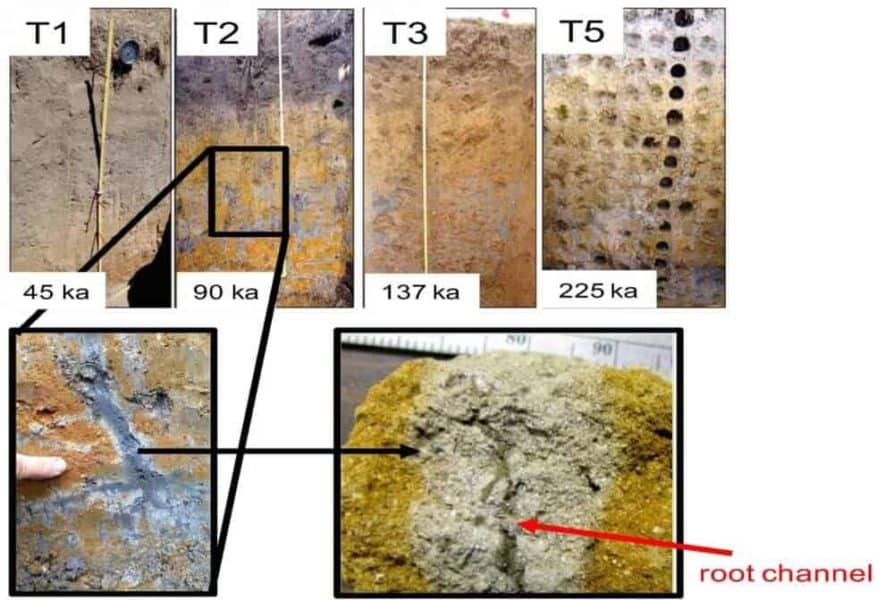Soils, especially those one meter down and deeper, play a critical role in the global carbon cycle and are estimated to hold more than three times the amount of carbon as the atmosphere, say researchers at the University of Massachusetts Amherst and an international team, but this deep soil carbon can be dramatically perturbed in response to environmental changes.
Deep carbon appears to be particularly vulnerable to increased root growth induced by elevated carbon dioxide levels in the air, by drying climate or vegetation change, the researchers say.
In a new early online paper this month in a ScienceDirect journal, first author and doctoral student Mariela Garcia-Arredondo, with her advisor, biogeochemist Marco Keiluweit in UMass Amherst’s Stockbridge School of Agriculture, and others, report how their new model is designed to predict how deep soil carbon responds to environmental change and to offer a better understanding of the mechanisms controlling soil carbon storage at depth, specifically root-driven weathering on carbon concentration, radiocarbon values and chemistry and mineral composition changes.
As Keiluweit explains, though root-derived organic compounds such as decaying roots, plant stems and trunks are recognized as an important source of soil carbon, the role of roots as a weathering agent that breaks down rocks and primary minerals over thousands of years to build soil has been overlooked.
“The significance of our work is that we not only show that plants are conduits of carbon into the soil, but the roots also regulate how much carbon the deep soil can store or lose,” says Keiluweit. Not only does root-driven weathering help to sequester carbon on soil minerals for centuries or longer, but it can also release stored carbon from minerals, which is then lost to the atmosphere as climate-active carbon dioxide, he points out.
Findings will have global ramifications for agricultural stakeholders that have held up the benefits of carbon sequestration in soils as their contribution to fighting climate change, Keiluweit points out, but “when you consider root activity in deeper soil, the question becomes one of the net effect – are you forming protective mineral-organic associations or destroying them?” he adds.
Further, “Periodic droughts affect agriculture systems and, currently, a lot of effort goes into developing and planting crops that are deeper rooting to access water. Deeper roots are better for yields, but it may release carbon that has been protected at depth.”
“On the flip side, our findings can also identify soils with potential for increased carbon storage at depth. Then you can have crops that not only extract water but also help deep storage of carbon,” Keiluweit says. He hopes this study will help the agriculture sector to consider what crops and soil will be best for combatting climate change.
“What we are showing here is that roots influence the formation of helpful mineral-organic associations by providing some of the minerals that can engage with organic matter, but then at the same time can destroy or disrupt some of these protective associations in later years,” he adds.
In addition to Keiluweit, Garcia-Arredondo and Morris Jones at UMass Amherst, Corey Lawrence and Marjorie Schultz of the U.S. Geological Survey, Malak Tfaily of the University of Arizona, Ravi Kukkadapu at Pacific Northwest National Laboratory (PNNL) and Kristin Boye at the Stanford Synchrotron Radiation Lightsource contributed to this project.
For this work, they examined mineral-organic transformations in relation to carbon dynamics in deep soil horizons of the Santa Cruz marine terraces in California, analyzing samples from four soil profiles ranging in age from 65,000 to 226,000 years old. They directly compared rhizosphere – the soil region near plant roots where their growth, respiration and nutrient exchange influence chemistry and microbiology – to non-rhizosphere soil in each profile.
The research team used a suite of analytical tools including radiocarbon measurements, quantitative sequential extractions as well as state-of-the-art instrumentation such as Mössbauer spectroscopy and scanning transmission X-ray microscopy at collaborating institutions including the U.S. Department of Energy’s Environmental Molecular Science Laboratory at PNNL in Richland, Washington, and the Canadian Light Source at the University of Saskatchewan in Saskatoon.


